YAMAHA XMAX 125 2013 Manual PDF
Manufacturer: YAMAHA, Model Year: 2013, Model line: XMAX 125, Model: YAMAHA XMAX 125 2013Pages: 96, PDF Size: 4.83 MB
Page 71 of 96
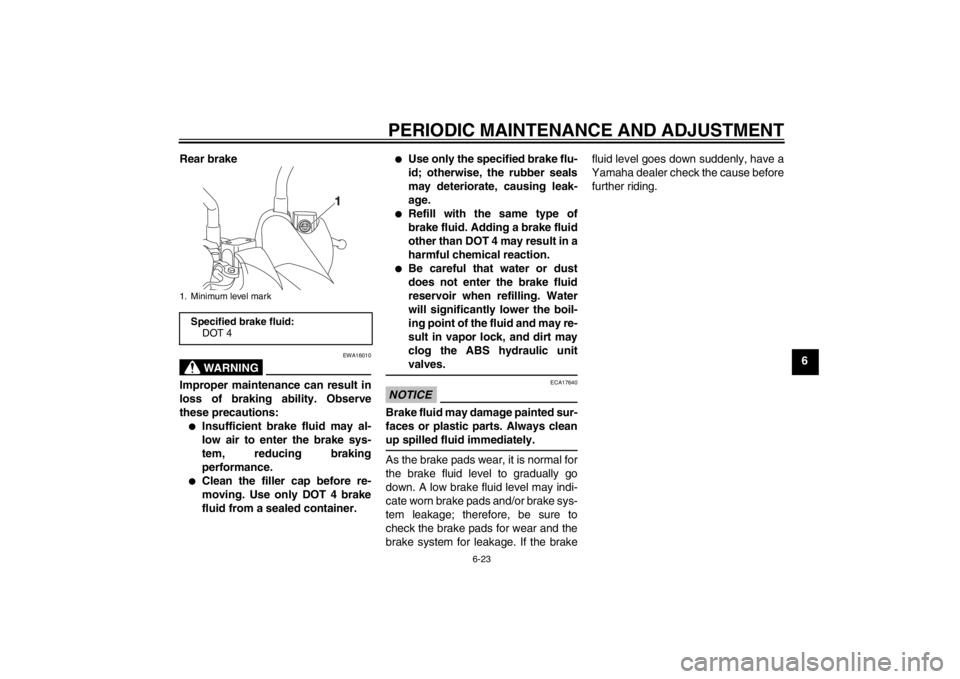
PERIODIC MAINTENANCE AND ADJUSTMENT
6-23
6 Rear brake
WARNING
EWA16010
Improper maintenance can result in
loss of braking ability. Observe
these precautions:●
Insufficient brake fluid may al-
low air to enter the brake sys-
tem, reducing braking
performance.
●
Clean the filler cap before re-
moving. Use only DOT 4 brake
fluid from a sealed container.
●
Use only the specified brake flu-
id; otherwise, the rubber seals
may deteriorate, causing leak-
age.
●
Refill with the same type of
brake fluid. Adding a brake fluid
other than DOT 4 may result in a
harmful chemical reaction.
●
Be careful that water or dust
does not enter the brake fluid
reservoir when refilling. Water
will significantly lower the boil-
ing point of the fluid and may re-
sult in vapor lock, and dirt may
clog the ABS hydraulic unit
valves.
NOTICE
ECA17640
Brake fluid may damage painted sur-
faces or plastic parts. Always clean
up spilled fluid immediately.As the brake pads wear, it is normal for
the brake fluid level to gradually go
down. A low brake fluid level may indi-
cate worn brake pads and/or brake sys-
tem leakage; therefore, be sure to
check the brake pads for wear and the
brake system for leakage. If the brakefluid level goes down suddenly, have a
Yamaha dealer check the cause before
further riding.
1. Minimum level markSpecified brake fluid:
DOT 4
U2ABE2E0.book Page 23 Thursday, August 30, 2012 2:36 PM
Page 72 of 96

PERIODIC MAINTENANCE AND ADJUSTMENT
6-24
6
EAU22732
Changing the brake fluid Have a Yamaha dealer change the
brake fluid at the intervals specified in
the periodic maintenance and lubrica-
tion chart. In addition, have the oil seals
of the master cylinders and calipers as
well as the brake hoses replaced at the
intervals listed below or whenever they
are damaged or leaking.●
Oil seals: Replace every two
years.
●
Brake hoses: Replace every four
years.
EAU23095
Checking and lubricating the
cables The operation of all control cables and
the condition of the cables should be
checked before each ride, and the ca-
bles and cable ends should be lubricat-
ed if necessary. If a cable is damaged
or does not move smoothly, have a
Yamaha dealer check or replace it.
WARNING! Damage to the outer
housing of cables may result in in-
ternal rusting and cause interfer-
ence with cable movement. Replace
damaged cables as soon as possi-
ble to prevent unsafe conditions.[EWA10711]EAU23114
Checking and lubricating the
throttle grip and cable The operation of the throttle grip should
be checked before each ride. In addi-
tion, the cable should be lubricated by a
Yamaha dealer at the intervals speci-
fied in the periodic maintenance chart.
The throttle cable is equipped with a
rubber cover. Make sure that the cover
is securely installed. Even though the
cover is installed correctly, it does not
completely protect the cable from water
entry. Therefore, use care not to pour
water directly onto the cover or cable
when washing the vehicle. If the cable
or cover becomes dirty, wipe clean with
a moist cloth.
Recommended lubricant:
Yamaha Chain and Cable Lube or
engine oil
U2ABE2E0.book Page 24 Thursday, August 30, 2012 2:36 PM
Page 73 of 96
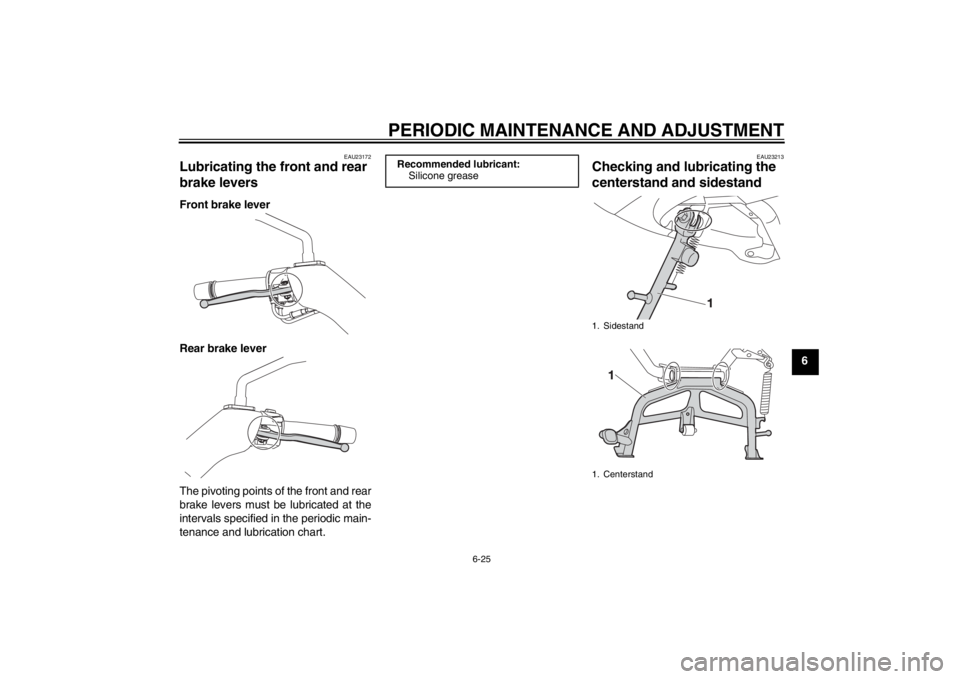
PERIODIC MAINTENANCE AND ADJUSTMENT
6-25
6
EAU23172
Lubricating the front and rear
brake levers Front brake lever
Rear brake lever
The pivoting points of the front and rear
brake levers must be lubricated at the
intervals specified in the periodic main-
tenance and lubrication chart.
EAU23213
Checking and lubricating the
centerstand and sidestand
Recommended lubricant:
Silicone grease
1. Sidestand
1. Centerstand
U2ABE2E0.book Page 25 Thursday, August 30, 2012 2:36 PM
Page 74 of 96
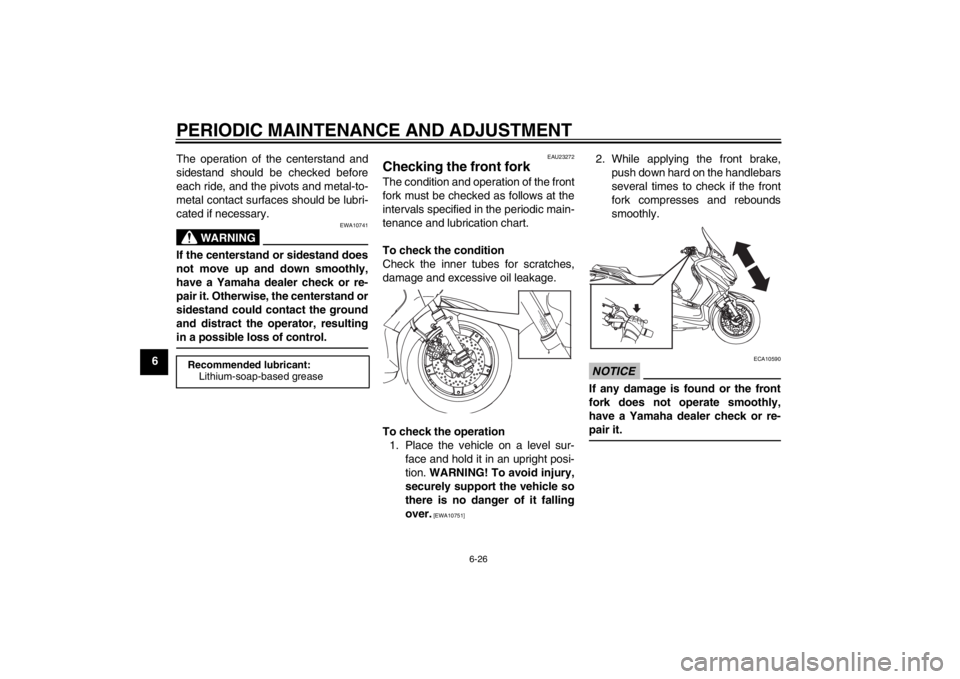
PERIODIC MAINTENANCE AND ADJUSTMENT
6-26
6The operation of the centerstand and
sidestand should be checked before
each ride, and the pivots and metal-to-
metal contact surfaces should be lubri-
cated if necessary.
WARNING
EWA10741
If the centerstand or sidestand does
not move up and down smoothly,
have a Yamaha dealer check or re-
pair it. Otherwise, the centerstand or
sidestand could contact the ground
and distract the operator, resulting
in a possible loss of control.
EAU23272
Checking the front fork The condition and operation of the front
fork must be checked as follows at the
intervals specified in the periodic main-
tenance and lubrication chart.
To check the condition
Check the inner tubes for scratches,
damage and excessive oil leakage.
To check the operation
1. Place the vehicle on a level sur-
face and hold it in an upright posi-
tion. WARNING! To avoid injury,
securely support the vehicle so
there is no danger of it falling
over.
[EWA10751]
2. While applying the front brake,
push down hard on the handlebars
several times to check if the front
fork compresses and rebounds
smoothly.NOTICE
ECA10590
If any damage is found or the front
fork does not operate smoothly,
have a Yamaha dealer check or re-
pair it.
Recommended lubricant:
Lithium-soap-based grease
U2ABE2E0.book Page 26 Thursday, August 30, 2012 2:36 PM
Page 75 of 96
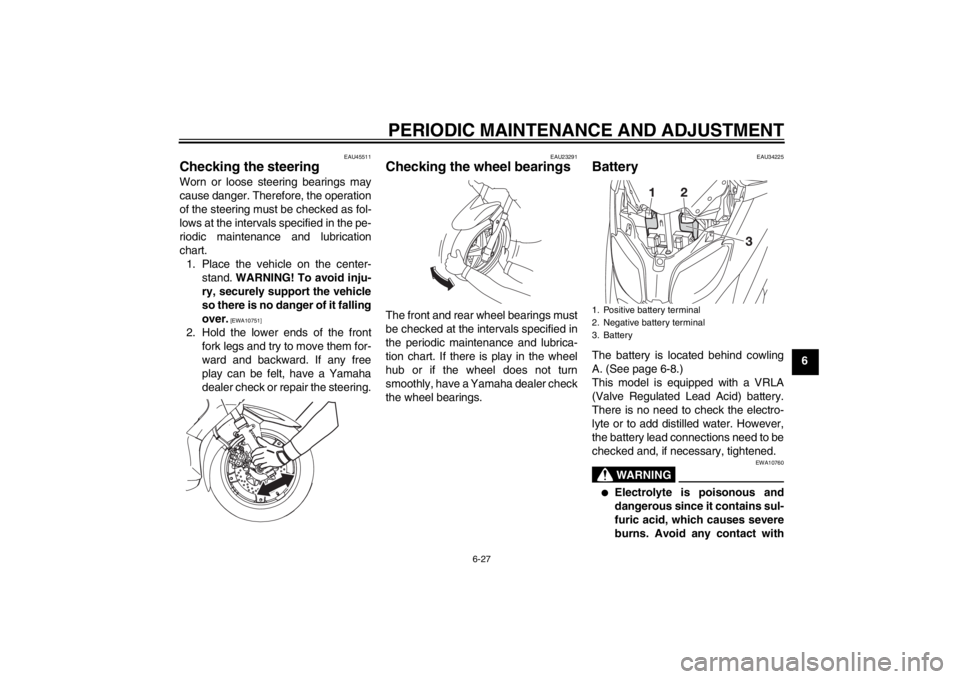
PERIODIC MAINTENANCE AND ADJUSTMENT
6-27
6
EAU45511
Checking the steering Worn or loose steering bearings may
cause danger. Therefore, the operation
of the steering must be checked as fol-
lows at the intervals specified in the pe-
riodic maintenance and lubrication
chart.
1. Place the vehicle on the center-
stand. WARNING! To avoid inju-
ry, securely support the vehicle
so there is no danger of it falling
over.
[EWA10751]
2. Hold the lower ends of the front
fork legs and try to move them for-
ward and backward. If any free
play can be felt, have a Yamaha
dealer check or repair the steering.
EAU23291
Checking the wheel bearings The front and rear wheel bearings must
be checked at the intervals specified in
the periodic maintenance and lubrica-
tion chart. If there is play in the wheel
hub or if the wheel does not turn
smoothly, have a Yamaha dealer check
the wheel bearings.
EAU34225
Battery The battery is located behind cowling
A. (See page 6-8.)
This model is equipped with a VRLA
(Valve Regulated Lead Acid) battery.
There is no need to check the electro-
lyte or to add distilled water. However,
the battery lead connections need to be
checked and, if necessary, tightened.
WARNING
EWA10760
●
Electrolyte is poisonous and
dangerous since it contains sul-
furic acid, which causes severe
burns. Avoid any contact with
1. Positive battery terminal
2. Negative battery terminal
3. Battery
U2ABE2E0.book Page 27 Thursday, August 30, 2012 2:36 PM
Page 76 of 96

PERIODIC MAINTENANCE AND ADJUSTMENT
6-28
6skin, eyes or clothing and al-
ways shield your eyes when
working near batteries. In case
of contact, administer the fol-
lowing FIRST AID.
EXTERNAL: Flush with plenty
of water.
INTERNAL: Drink large quan-
tities of water or milk and im-
mediately call a physician.
EYES: Flush with water for 15
minutes and seek prompt
medical attention.
●
Batteries produce explosive hy-
drogen gas. Therefore, keep
sparks, flames, cigarettes, etc.,
away from the battery and pro-
vide sufficient ventilation when
charging it in an enclosed
space.
●
KEEP THIS AND ALL BATTER-
IES OUT OF THE REACH OF
CHILDREN.
To charge the battery
Have a Yamaha dealer charge the bat-
tery as soon as possible if it seems to
have discharged. Keep in mind that thebattery tends to discharge more quickly
if the vehicle is equipped with optional
electrical accessories.
NOTICE
ECA16521
To charge a VRLA (Valve Regulated
Lead Acid) battery, a special (con-
stant-voltage) battery charger is re-
quired. Using a conventional battery
charger will damage the battery.To store the battery
1. If the vehicle will not be used for
more than one month, remove the
battery, fully charge it, and then
place it in a cool, dry place.
NOTICE: When removing the
battery, be sure the key is
turned to “OFF”, then discon-
nect the negative lead before
disconnecting the positive lead.
[ECA16302]
2. If the battery will be stored for more
than two months, check it at least
once a month and fully charge it if
necessary.
3. Fully charge the battery before in-
stallation. NOTICE: When install-
ing the battery, be sure the keyis turned to “OFF”, then con-
nect the positive lead before
connecting the negative lead.
[ECA16840]
4. After installation, make sure that
the battery leads are properly con-
nected to the battery terminals.NOTICE
ECA16530
Always keep the battery charged.
Storing a discharged battery can
cause permanent battery damage.
U2ABE2E0.book Page 28 Thursday, August 30, 2012 2:36 PM
Page 77 of 96
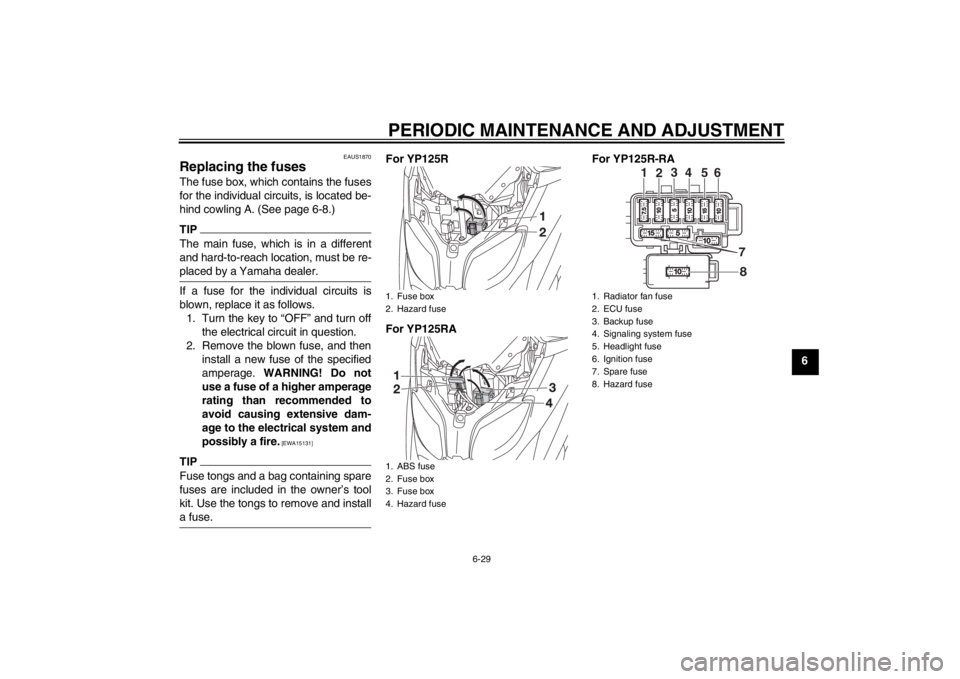
PERIODIC MAINTENANCE AND ADJUSTMENT
6-29
6
EAUS1870
Replacing the fuses The fuse box, which contains the fuses
for the individual circuits, is located be-
hind cowling A. (See page 6-8.)TIPThe main fuse, which is in a different
and hard-to-reach location, must be re-
placed by a Yamaha dealer.If a fuse for the individual circuits is
blown, replace it as follows.
1. Turn the key to “OFF” and turn off
the electrical circuit in question.
2. Remove the blown fuse, and then
install a new fuse of the specified
amperage. WARNING! Do not
use a fuse of a higher amperage
rating than recommended to
avoid causing extensive dam-
age to the electrical system and
possibly a fire.
[EWA15131]
TIPFuse tongs and a bag containing spare
fuses are included in the owner’s tool
kit. Use the tongs to remove and install
a fuse.
For YP125R
For YP125RAFor YP125R-RA1. Fuse box
2. Hazard fuse
1. ABS fuse
2. Fuse box
3. Fuse box
4. Hazard fuse
1. Radiator fan fuse
2. ECU fuse
3. Backup fuse
4. Signaling system fuse
5. Headlight fuse
6. Ignition fuse
7. Spare fuse
8. Hazard fuse
7
1
2
3
4
5
6
.
U2ABE2E0.book Page 29 Thursday, August 30, 2012 2:36 PM
Page 78 of 96
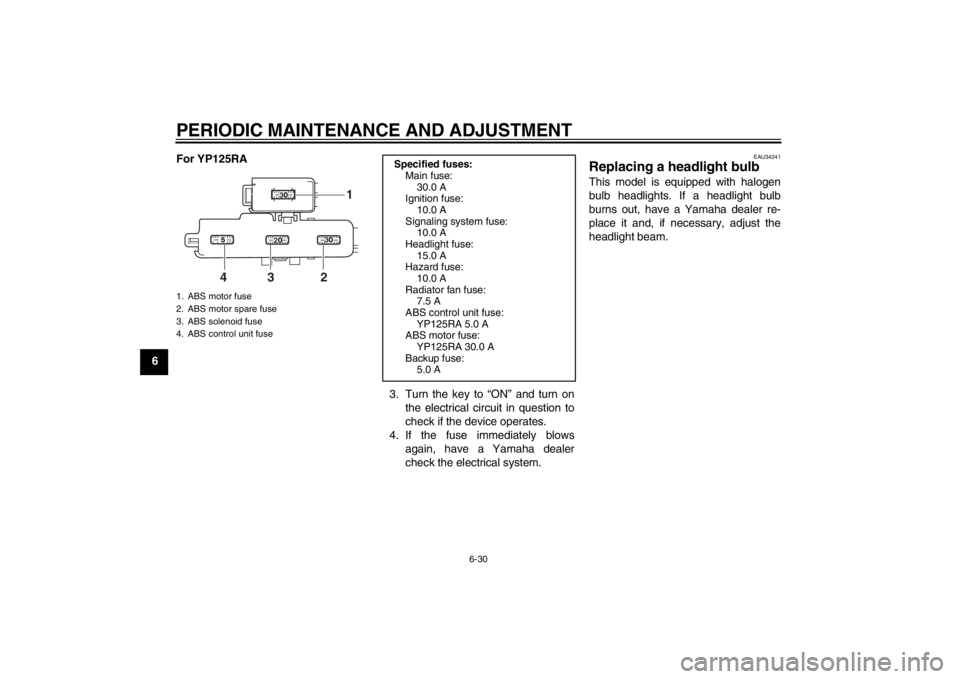
PERIODIC MAINTENANCE AND ADJUSTMENT
6-30
6For YP125RA
3. Turn the key to “ON” and turn on
the electrical circuit in question to
check if the device operates.
4. If the fuse immediately blows
again, have a Yamaha dealer
check the electrical system.
EAU34241
Replacing a headlight bulb This model is equipped with halogen
bulb headlights. If a headlight bulb
burns out, have a Yamaha dealer re-
place it and, if necessary, adjust the
headlight beam.
1. ABS motor fuse
2. ABS motor spare fuse
3. ABS solenoid fuse
4. ABS control unit fuse
1
23
3
2
4
3
Specified fuses:
Main fuse:
30.0 A
Ignition fuse:
10.0 A
Signaling system fuse:
10.0 A
Headlight fuse:
15.0 A
Hazard fuse:
10.0 A
Radiator fan fuse:
7.5 A
ABS control unit fuse:
YP125RA 5.0 A
ABS motor fuse:
YP125RA 30.0 A
Backup fuse:
5.0 A
U2ABE2E0.book Page 30 Thursday, August 30, 2012 2:36 PM
Page 79 of 96
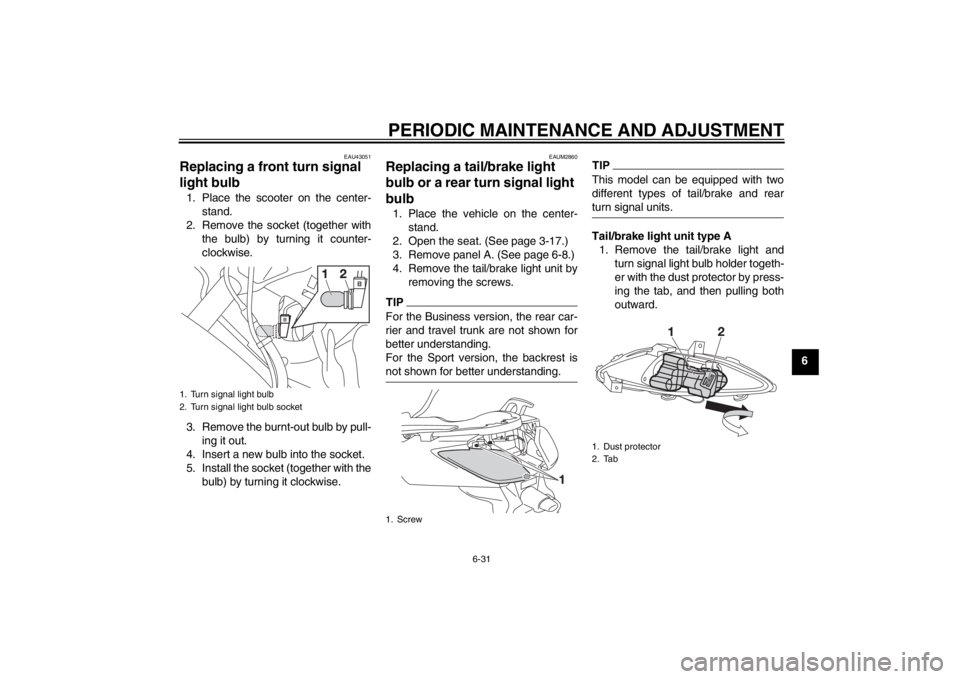
PERIODIC MAINTENANCE AND ADJUSTMENT
6-31
6
EAU43051
Replacing a front turn signal
light bulb 1. Place the scooter on the center-
stand.
2. Remove the socket (together with
the bulb) by turning it counter-
clockwise.
3. Remove the burnt-out bulb by pull-
ing it out.
4. Insert a new bulb into the socket.
5. Install the socket (together with the
bulb) by turning it clockwise.
EAUM2860
Replacing a tail/brake light
bulb or a rear turn signal light
bulb 1. Place the vehicle on the center-
stand.
2. Open the seat. (See page 3-17.)
3. Remove panel A. (See page 6-8.)
4. Remove the tail/brake light unit by
removing the screws.TIPFor the Business version, the rear car-
rier and travel trunk are not shown for
better understanding.
For the Sport version, the backrest is
not shown for better understanding.
TIPThis model can be equipped with two
different types of tail/brake and rear
turn signal units.Tail/brake light unit type A
1. Remove the tail/brake light and
turn signal light bulb holder togeth-
er with the dust protector by press-
ing the tab, and then pulling both
outward.
1. Turn signal light bulb
2. Turn signal light bulb socket
1. Screw
1. Dust protector
2. Tab
U2ABE2E0.book Page 31 Thursday, August 30, 2012 2:36 PM
Page 80 of 96
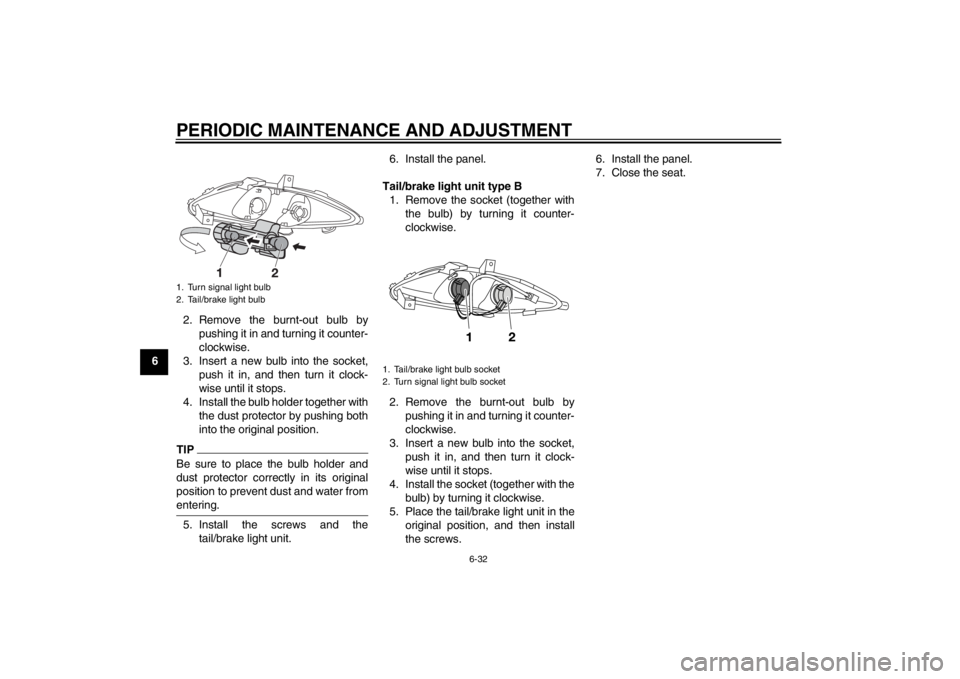
PERIODIC MAINTENANCE AND ADJUSTMENT
6-32
62. Remove the burnt-out bulb by
pushing it in and turning it counter-
clockwise.
3. Insert a new bulb into the socket,
push it in, and then turn it clock-
wise until it stops.
4. Install the bulb holder together with
the dust protector by pushing both
into the original position.
TIPBe sure to place the bulb holder and
dust protector correctly in its original
position to prevent dust and water from
entering.5. Install the screws and the
tail/brake light unit.6. Install the panel.
Tail/brake light unit type B
1. Remove the socket (together with
the bulb) by turning it counter-
clockwise.
2. Remove the burnt-out bulb by
pushing it in and turning it counter-
clockwise.
3. Insert a new bulb into the socket,
push it in, and then turn it clock-
wise until it stops.
4. Install the socket (together with the
bulb) by turning it clockwise.
5. Place the tail/brake light unit in the
original position, and then install
the screws.6. Install the panel.
7. Close the seat.1. Turn signal light bulb
2. Tail/brake light bulb
1. Tail/brake light bulb socket
2. Turn signal light bulb socket
U2ABE2E0.book Page 32 Thursday, August 30, 2012 2:36 PM